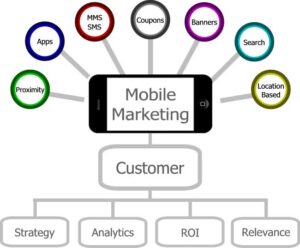In today’s fast-paced digital era, where smartphones have become an extension of ourselves, mobile marketing has emerged as a dynamic and influential strategy for connecting with audiences on a deeply personal level. With the power to reach customers literally in the palm of their hands, mobile marketing has transformed the way businesses engage, communicate, and convert their target demographics.
Mobile marketing refers to the practice of optimizing marketing strategies for mobile devices, ranging from smartphones and tablets to wearable gadgets.

This approach recognizes that people are increasingly reliant on their mobile devices for a myriad of activities, from browsing the web and socializing to shopping and even managing their daily tasks. As a result, businesses have capitalized on this trend to tailor their marketing efforts to meet consumers where they are most active—on their mobile devices.
One of the standout features of mobile marketing is its unparalleled immediacy and proximity. By leveraging technologies such as SMS (Short Message Service) and push notifications, brands can deliver time-sensitive promotions, personalized offers, and relevant updates directly to their customers’ devices. This level of instant communication fosters a sense of connection and engagement that is unparalleled in traditional marketing channels.
Mobile apps also play a pivotal role in mobile marketing. These apps provide a dedicated space for businesses to offer an immersive, user-friendly experience. From e-commerce platforms and food delivery services to banking apps and fitness trackers, mobile apps enable brands to provide value directly through their customers’ smartphones. Moreover, apps can collect valuable user data, allowing businesses to fine-tune their marketing strategies based on real-time insights into user behavior and preferences.

Location-based marketing
is another dimension of mobile marketing that capitalizes on the GPS capabilities of smartphones. By delivering targeted content and promotions based on a user’s geographic location, businesses can create hyper-localized campaigns that resonate with consumers in their immediate vicinity. This approach has proven highly effective in driving foot traffic to physical stores, engaging event attendees, and enhancing the overall customer experience.
Social media’s integration with mobile devices has further amplified the impact of mobile marketing. Platforms like Instagram, Facebook, and TikTok provide immersive, visually-driven experiences that align seamlessly with the mobile user’s habits. Brands can deploy engaging content, influencer collaborations, and interactive ads to capture users’ attention within their social media feeds, making the most of their limited screen time.
As mobile marketing continues to evolve, embracing technologies like augmented reality (AR) and virtual reality (VR) is becoming increasingly common. These technologies offer new dimensions of interaction and engagement, allowing customers to experience products and services in innovative and captivating ways. Brands can create memorable and shareable experiences that leave a lasting impression on their audience.
In conclusion,
mobile marketing has revolutionized the way businesses connect with customers, utilizing the ubiquity of smartphones to establish a more intimate and immediate relationship. Through techniques such as push notifications, mobile apps, location-based targeting, and social media engagement, brands can effectively reach their target audiences in a way that aligns with modern consumer behavior. By recognizing the power of mobile devices and tailoring their strategies accordingly, businesses can position themselves at the forefront of this dynamic and ever-evolving landscape.
Welcome,
To the cutting-edge world of digital marketing at 360 Digital Marketing Institute in Thane! Our institute stands as a beacon of knowledge and innovation in the realm of online promotion, equipping individuals with the power to thrive in the digital landscape.
At 360 Digital Marketing Institute, we’re not just about teaching a course; we’re about shaping careers and fostering success stories. Our flagship offering, the Advanced Digital Marketing Course, is meticulously designed to transform enthusiasts into experts. Whether you’re a fresh graduate, a budding entrepreneur, or a professional looking to upskill, our course opens doors to limitless opportunities.

